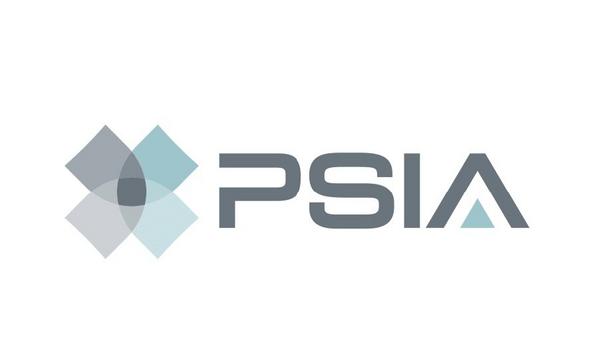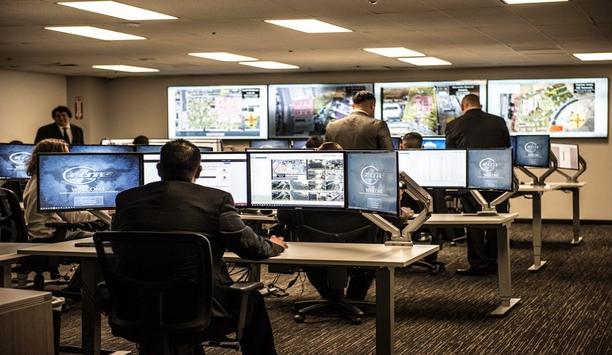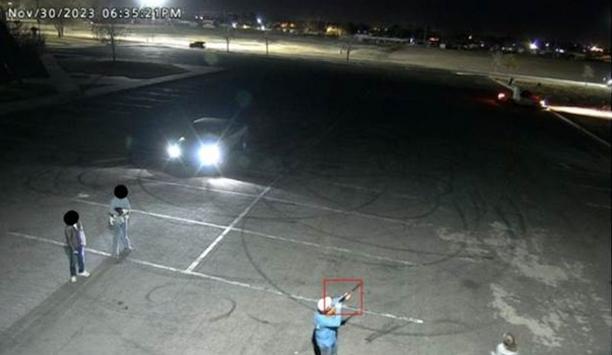Veterans in security
LOOKOUT, a pioneering provider of marine AI systems for safety, announced the expansion of its product line by introducing a new camera featuring an integrated navigation light. This new camera system offers enhanced safety and greater installation flexibility and is available in LOOKOUT's classic blue and white, matte black with carbon accents and custom colours by request, to complement a wider range of vessel designs. Advanced AI vision cameras LOOKOUT has solved a common installation dile...
ZE Government Solutions (ZEGS), a wholly owned subsidiary of A.I.-based gun detection pioneer ZeroEyes, announced it has partnered with HavocAI Inc., a pioneering innovator in autonomous uncrewed surface vessel technology, to deliver customised computer vision capabilities that will be integrated with HavocAI’s maritime autonomy platforms. HavocAI’s technology enables a single operator to command and control thousands of autonomous assets. The company's platform is designed to provi...
Building Intelligence, a provider of solutions that securely streamline vendor, vehicle, and visitor access, announces a pioneer transition to support its next phase of growth. The new pioneer structure will help the company scale operations and refine its organizational strategy to pursue new growth opportunities. Focusing on expansion Championing innovation and partnership with strategic growth and market-defining innovationFounder Jeffrey Friedman will assume the role of Chief Evange...
On March 18, 2025, members of the security industry will hear an impactful and personal assessment of the tragic and devastating wildfires upon the surrounding communities and offer the opportunity for interested industry stakeholders to discuss a potential role in the recovery efforts. This program, co-presented by the Security Industry Association, the Electronic Security Association, PSA and The Monitoring Association, is developed for information purposes and to raise awareness of current r...
ISS (Intelligent Security Systems), a pioneering provider of video intelligence and data awareness solutions, is excited to announce the appointment of Phil Jensen as its new Director of Sales for Under Vehicle Surveillance Systems (UVSS). Jensen brings a wealth of experience and expertise to ISS, particularly in government sales, technical security solutions, and growth-focused strategies. Prior to joining ISS, he held the position of Director of Government Business Development and Sales at A...
Everon, a pioneering security integrator and premier provider of commercial security, fire and life safety solutions in the U.S., announced that Bobby Dale has joined the executive leadership team in the role of Chief Customer Officer. With over 40 years of sales and executive leadership experience in the industry, Dale is a seasoned commercial security veteran. He previously served in prominent roles at Protection 1, ADT, and ADT Commercial. Prior roles of Dale Dale will lead Everon’s...
News
IronYun, a pioneer in Vision AI for security, safety, and enterprise operations, announced its board of directors has named Salesforce and ServiceNow veteran Marshall Tyler as its new Chief Executive Officer. Tyler’s appointment follows a period of 3x growth at IronYun, reflecting increasing demand for the company’s Vaidio® AI Vision Platform, which transforms conventional video into actionable visual intelligence. Prior roles of Tyler Tyler joined IronYun as COO in 2024 after serving as Chief Strategy Officer at ClickUp Tyler joined IronYun as COO in 2024 after serving as Chief Strategy Officer at ClickUp. He has led large, cross-functional initiatives at several fast-growing software companies, translating customer needs into effective go-to-market programs. At ServiceNow, he successfully launched a cross-functional program to unify sales, product, engineering, and marketing efforts that drove record growth across key industries. At Salesforce, he helped make Latin America the company’s fastest-growing region. Next level of growth and innovation “Marshall’s exceptional track record driving growth at scale for global enterprise software companies is exactly what our company and our customers need at this stage,” said Paul Sun, former CEO of IronYun and now Founder, President. “We’ve built a great company with strong market momentum and a customer focused culture. Under Marshall’s leadership, we will take the company to the next level of growth and innovation.” Role in industry initiatives IronYun plays a prominent role in industry initiatives, leveraging his decades of leadership in the field Sun will remain with the company, continuing to advise customers and ensuring IronYun plays a prominent role in industry initiatives, leveraging his decades of leadership in the field. He will also support Tyler in expanding Vaidio’s capabilities as the company taps new markets interested in the platform for its flexibility and advanced analytics. Vaidio addresses challenges IronYun’s Vaidio platform has been rapidly adopted by organisations of all sizes due to its accuracy and flexibility in real-time detection, forensic video search capabilities and data-driven insights. By turning raw video into a rich source of intelligence, Vaidio addresses challenges like public safety, asset protection, and operational optimisation with a single, scalable solution. Vaidio AI Vision platform Vaidio has gained recognition for usability, high performance, and rapid time to value As organisations worldwide adopt Vision AI to help drive decisions and improve experiences and outcomes, Vaidio has gained recognition for usability, high performance, and rapid time to value. “There is immense opportunity ahead because the Vaidio AI Vision platform acts like an ROI multiplier across both security and operations,” said Marshall Tyler, CEO and President at IronYun. New era of visual transformation Tyler added: “We’re playing to win – and we’re opening up a new era of visual transformation for our customers. Not only do their existing cameras become instantly smarter, but they can also see more and do more with their video data than they ever thought possible.” IronYun will showcase the Vaidio AI Vision Platform at the upcoming ISC West conference. Attendees can learn more and meet Marshall and the IronYun team at Stand 7117.
IDIS Americas is expanding its footprint in the U.S. ahead of ISC West (April 2025, Las Vegas), reinforcing its market position with a growing team, an expanded technology portfolio, and a robust pipeline of innovative solutions. With a strengthening presence across key verticals - including critical infrastructure, traffic (ITS), transit, retail, education, logistics, and small to medium businesses - IDIS provides end-to-end video surveillance solutions, including the very latest AI analytics, that enhance security, streamline operations, and deliver long-term value. Demands of various applications IDIS technology is designed to meet the unique demands of various applications From enterprise-scale deployments to compact, cost-efficient solutions, IDIS technology is designed to meet the unique demands of various applications. Following last year’s merger with Costar, IDIS Americas is executing an ambitious strategy to expand its influence across North America. “We’ve made rapid progress since unifying operations, and now we’re doubling down on growth in the Western U.S.,” said CEO Scott Switzer. “With strategic investments in top talent and cutting-edge technology, we’re positioned to bring even more value to our customers and integration partners.” Latest end-to-end video solutions This expansion brings exciting opportunities for customers to upgrade their systems, leveraging AI-driven tools that simplify video management while delivering more sustainable, cost-effective solutions. At ISC West, IDIS will showcase its latest end-to-end video solutions, including the enhanced IDIS Vaidio™ fully integrated AI Suite, designed to improve security, safety, and operational efficiency with advanced video analytics. Systems integrators with exclusive advantages The program ensures integrators have the help and expertise must to deliver high-performance Additionally, IDIS Americas is launching a new Partner Program, designed to empower systems integrators with exclusive advantages. Members will gain priority support, tailored training, and access to cutting-edge security solutions that drive growth and success. The program ensures integrators have the resources and expertise needed to deliver seamless, high-performance deployments across a range of industries. IDIS’s commitment As part of its expansion, IDIS Americas has bolstered its team with experienced professionals across sales, engineering, and project management. Darron Parker, an industry veteran with extensive experience in security, telecoms, and retail, has been appointed as VP Sales, Northeast U.S. & Canada. He joins a growing roster of specialists dedicated to supporting partners and customers, reinforcing IDIS’s commitment to delivering best-in-class solutions and unmatched customer service across multiple industries.
Ivanti, the software company that breaks down barriers between IT and security so that Everywhere Work can thrive, announced that it has named current Ivanti COO Dennis Kozak as Chief Executive Officer (CEO) in a planned transition, effective January 1, 2025. He succeeds Jeff Abbott, who will remain on the Company’s board of directors. Ivanti’s next CEO “Dennis has led our sales, marketing, and operations organisations through a period of rapid expansion with four acquisitions, delivering on our vision of the market’s first purpose-built solution for CIOs and CISOs – all while generating tremendous SaaS growth,” said Mr. Abbott. “I am stepping down with great confidence in Dennis as Ivanti’s next CEO. He understands our customers’ desired business outcomes and has built a strong go-to-market model to consistently drive customer success.” Prior roles of Kozak Kozak joined Ivanti in April 2022, bringing a successful track record of driving sales growth An industry veteran, Mr. Kozak joined Ivanti in April 2022, bringing a successful track record of driving sales growth, establishing top-tier partnerships, and integrating acquisitions. Prior to joining Ivanti, Mr. Kozak served in leadership roles at Avaya. He previously spent 22 years with CA Technologies, where he led several organisations such as global sales, global channel sales and strategy, and sales operations, as well as a global business transformation to deliver a next-generation portfolio strategy. Demand for a security platform “I am honoured to take the role of CEO at such an exciting time for Ivanti,” said Mr. Kozak. “I continue to be inspired by the incredible innovation and service to customers provided by our great team." "Our research has shown there is strong demand for a security and IT solution platform, and with Ivanti at the forefront of this technology, we are confident we can execute on our vision.” Integral part of Ivanti’s success “Dennis has been an integral part of Ivanti’s success since joining in 2022 and he is absolutely the right pioneer to take Ivanti and our customers into the next chapter,” said Chris Heim, Co-Chair of Ivanti’s Board. “We are also grateful to Jeff for his leadership over the past five years and look forward to his continued service on our board of directors.”
Cohesity, a pioneer in AI-powered data security announced the appointment of Vasu Murthy as SVP and Chief Product Officer. Vasu Murthy Murthy is a veteran with over 25 years of experience building enterprise software at scale. He has successfully led software launches at companies ranging from day-zero startups to large, global brands, with strengths in driving rapid growth and managing complex multi-product scaling efforts. Murthy will bring this vast experience in data protection, security, and analytics to Cohesity to further its industry-leading AI-powered data security portfolio. Work experience Before Rubrik, Murthy was VP of Products for the Analytics Platform at Oracle, launching several $100M+ products Murthy joined Cohesity from Rubrik, where he was VP of Products and was responsible for the company’s core product, platform, and technology partnerships. He helped grow Rubrik’s ARR tenfold over six years to IPO while navigating transformation across three fronts: software to subscription, on-prem to cloud, and backup to data security. Before Rubrik, Murthy was VP of Products for the Analytics Platform at Oracle, launching several $100M+ products while driving market-leading innovation and cloud transformation. He joined via its acquisition of DataScaler, an in-memory database company he co-founded. Murthy is an IIT Kharagpur graduate based in the Bay Area. Customer-first mindset “Vasu’s strong experience supporting organisations through significant growth and transformational change with a customer-first mindset, as well as his deep domain expertise, made him the perfect fit for Cohesity,” said Sanjay Poonen, president and CEO, of Cohesity. “Vasu has consistently delivered exceptional results in his past experiences, shaping product portfolios to meet customer needs while driving business evolution and transformation. His data protection, security, and analytics expertise will help us further extend our innovations as we enter a new era of Cohesity in the coming years.” Enterprise data protection “Cohesity has taken an aggressive and innovative approach to leveraging AI to strengthen the security of its platform and offer customers new insight into their business data." "And combining Cohesity with Veritas’ enterprise data protection business will only bring more resources to develop new products at scale, something I’m deeply excited about,” said Murthy. Differentiated vision and platform “Cohesity has a differentiated vision and platform that has the potential to transform the industry completely." "As we scale our R&D investments and build best-in-class offerings to support global customers, I look forward to partnering with the team to make a bigger impact. I’m thrilled to join Cohesity in their journey as we enter the next growth phase.” Recent Cohesity highlights Murthy joins Cohesity during a time of significant momentum: In February, Cohesity announced its intent to combine with Veritas’ data protection business. In March, Cohesity announced a collaboration with NVIDIA to help organisations safely unlock the power of generative AI, resulting in NVIDIA becoming a new investor. In April, Cohesity extended its collaboration with IBM to strengthen cyber resilience, which resulted in IBM's investment in the company. In August, Forbes named Cohesity for the fifth time in its 2024 Cloud 100, and CRN recognised Cohesity Gaia as a 2024 Tech Innovator in the artificial intelligence category. The company continued to bolster its product offerings and drive strategic partner growth, building its strategic partnership with Crowdstrike, expanding its collaboration with Intel, and recently announcing its advanced visualisation tool for Gaia. Throughout the year, Cohesity’s leadership team welcomed deep industry expertise to continue driving market leadership, including the addition of Dr. Craig Martell as CTO and the appointments of Olivier Savornin and Fraser Hutchinson in EMEA.
adCAPTCHA, a new specialist security verification platform, has launched with £1m funding to tackle the ‘bots epidemic’ and protect organisations against cyber fraud. The London-based company, founded by industry veteran and entrepreneur Alfie Scarborough, equips organisations with the capability to identify and block bots through its sophisticated in-house developed patent-pending human verification technology. Layered security solution adCAPTCHA’s layered security solution leverages the infinite variation and constant change of media adCAPTCHA’s layered security solution leverages the infinite variation and constant change of media, generates billions of unique pathways, as well as behavioural analytics capabilities. It is estimated that 50 percent of global web traffic is made up of bots, with leading brands losing millions every day due to fraudulent views and impressions from non-existent customers. Human verification process The platform has been crafted to allow marketers and branding professionals to protect against online fraud, with bot-enabled false impressions repeatedly draining marketing budgets and resources. adCAPTCHA also allows brands to optimise the human verification process for advertising and cross-selling new products and services. The platform’s APIs also provide users with the ability to integrate into CMS and media libraries. Angel investors and entrepreneurs The verification system includes swipe to complete, puzzle piece and gamification tools The verification system includes swipe to complete, puzzle piece and gamification tools to confirm if the user is human. The company’s £1m funding, provided by a series of angel investors and entrepreneurs, will allow adCAPTCHA to develop its global offering, targeting the UK and US markets as well as Europe. Era of human verification technology Alfie Scarborough, Founder and CEO of adCAPTCHA said: “The verification market is plagued by poorly performing products that fail to accurately distinguish between bots and humans. The status quo leaves brands open to major cyber-attacks, unlimited spam as well as decimated marketing budgets." "Our offering will change all that – giving brands a comprehensive solution to identify and block bots, whilst empowering dynamic brand advertising to engage customers. Our mission is to usher in a new era of human verification technology and set the industry standard for the future.”
The PSIA announced that two of its members actively supporting the PKOC specification will be speaking at the CONSULT 2024 Symposium. Since its inception, eight years ago, CONSULT has emerged as one of the premier and most unique events in the security industry. The symposium fills a largely unmet need in the security industry for manufacturers and consultants to interact with each other, to better understand security technologies, trends, and techniques as they impact security consultants, and to create an environment for the development of valuable relationships. Security by Design Ed founded Security by Design over 50 years ago and has built it into an international powerhouse Jason Ouellette, a 30-year veteran of the security industry and the Chairman of the PSIA will be joined by Ed Chandler, one of the most respected consultants in the industry. Ed founded Security by Design over 50 years ago and has built it into an international powerhouse, serving an impressive list of enterprise customers. Latest development in PKOC “We look forward to having Ed Chandler and Jason Ouellette explain the latest development in PKOC at CONSULT 2024. Past years’ presentations have not only increased the understanding of PKOC, but have added to the enthusiasm behind it,” said Ray Coulombe, Founder and Managing Director of Security Specifiers, the sponsor of CONSULT 2024. “I envision that this year will be no different. Congratulations to PSIA for making PKOC a reality and valuable resource to the industry,” noted Coulombe. Commercial and security advantages At Consult, Jason and Ed will be providing participants an update on the PKOC specification, its capabilities and opportunities. “The session offers a chance to dig in to the details of PKOC: how it works, why it makes sense, how to specify it, what is available from the manufacturers to create a fully functional PKOC environment. We are looking forward to seeing all of you,” noted Chandler. PKOC creates truly secure and interoperable credentials. The commercial and security advantages of the asymmetric key based credential over traditional symmetric keys which they have been using for decades is finally attainable with the PKOC standard. A public key-based solution can not be underestimated in its value over traditional credential solutions. PKOC Bluetooth 3.0 specification The 3.0 spec features enhanced cryptography, which keeps all Bluetooth hardware The PSIA recently introduced the PKOC Bluetooth 3.0 specification at GSX 2024. The 3.0 spec features enhanced cryptography, which supports all Bluetooth hardware. In addition, the spec has been optimised to reduce the time it takes to authenticate. The PKOC specification leverages the concept of PKI without the need for the typical complex, expensive identity Infrastructure necessary for PKI. Private-public key handshake PKOC uses the device itself to generate the private & public key pair (known as Keygen) enabling the private-public key handshake to authenticate the credential. The beauty of PKOC is that the private key never leaves the device, and the public key becomes the “badge #” which can be easily shared with any system or device used to control access. With PKOC the USER literally “owns” the encryption keys and does not require any complicated process for managing or sharing keys. Furthermore, PKOC enables you to “Bring Your Own Credential” (BYOC).


Expert commentary
The average business owner or investor has some kind of security precaution in place, especially in the after-hours when there are fewer deterrents to inhibit criminal activity. Security guards, video surveillance systems, motion sensor lights, or even just fake cameras placed around the property are some of the common options people choose. Future of overnight security Smart business owners are starting to realise, however, that some of these traditional security measures are becoming antiquated and no longer cutting. The now and future of overnight security is in remote guarding. Pioneered by companies like Los Angeles-based Elite Interactive Solutions, which was founded back in 2007, remote guarding is revolutionising the overnight security business. Minimising criminal activity Remote guarding is fast becoming the most popular choice among commercial end-user property owners Remote guarding utilises a combination of cutting-edge technology, “digital guards,” highly trained security agents, and local law enforcement if and when necessary to minimise the potential of criminal activity. For those adequately enlightened to its overwhelmingly impressive crime prevention capabilities, remote guarding is fast becoming the most popular choice among commercial end-user property owners to secure and protect their investments. What Is remote guarding? Remote guarding is a revolutionary concept and increasing trend in security systems that utilises a combination of methods to effectively analyse potential threats to property. Cameras and/or other monitoring devices running highly advanced algorithmic software are installed in strategic areas or vulnerable places onsite and remotely located security agents are immediately notified of any activity within a designated perimeter of the property. A blend of AI, cybersecurity, and video analytics When properly deployed by an expert provider, the technology stack includes a proprietary blend of video analytics, artificial intelligence, cybersecurity, and more. Done right, “noise” is effectively filtered out, allowing agents to act on legitimate alerts and achieve zero false alarms communicated to first responders. Today, there are a lot of terms and descriptions tossed around about remote guarding, remote video, virtual guarding, etc., but those attributes must be present to represent the true definition of the offering and its many virtues. Realtime situational awareness Many systems have a two-way speaker that allows the security agent to give a verbal warning When specially trained security agents are alerted to trespassers, possible intruders, or other suspicious activity, they analyse the situation in real-time and determine the necessary level of action. Many systems have a two-way speaker that allows the security agent to give a verbal warning, known as a voice-down, to the individual(s) that they are being watched. Most perpetrators, often believing the response is emanating directly from security personnel on the property itself rather than from a remote command centre, flee immediately. However, if the threat persists, the security agent enlists local law enforcement to get on the scene. Customised remote guarding When properly deployed, remote guarding systems are also customised to specific properties. A team of consultants visits the client’s property to evaluate its vulnerabilities and where to best place cameras and/or other monitoring devices for system efficacy. Traditional security shortfalls According to Keith Bushey, a retired commander for the Los Angeles Police Department, there is much frustration between law enforcement officers and potential victims of crime due to the historically unreliable performance of traditional burglar alarm systems and central monitoring stations. He states about 90% of security-related calls are false alarms, a problem that has been well-documented through the years. Onsite challenges When a legitimate emergency does occur, the perpetrators have often already done their damage When a legitimate emergency does occur, the perpetrators have often already done their damage and/or escaped by the time law enforcement arrives. Onsite security guards are not the remedy either as they bring their own set of issues and challenges. Unexpected costs Traditional security systems can also have unexpected costs. The cost is not only in the security guards’ paycheck or the cost of the equipment itself. The cost comes when an actual incident occurs. In worst-case scenarios, the security guard(s) are injured, the business suffers inventory loss, and/or damage is sustained to the property. The medical and other costs for the security guard(s), the loss of inventory, property damage, deployment of law enforcement resources, and possible fallout of legal expenses all add up. Even in the best-case scenario, false alarm expenses incur if law enforcement is dispatched. These, among many others, are some of the primary issues that remote guarding resoundingly answers as a superior alternative. A bounty of benefits Remote guarding systems have been proven to cut costs and be more effective than traditional security systems. Even though the monthly monitoring costs of remote guarding are significantly higher than traditional intrusion detection system monitoring, the much higher effectiveness in crime reduction, elimination of false alarms, and augmenting or replacement of manned guards result in a substantially higher return on investment (ROI) to the end user. Easy tracking of threats The security cameras already have their image captured on record, making them easier to track down For example, case studies have demonstrated reduced security costs for clients by 60%, on average. These reductions have come from the costs of security staff, inventory, or property loss, plus saving money on insurance premiums and deductibles. The nature of remote guarding reduces the risk and costs of false alarms, with professional security agents able to determine an actual threat before law enforcement is called. In a rare instance when a perpetrator escapes before law enforcement arrives or can detain the individual(s), the security cameras already have their image captured on record, making them easier to track down and identify. Reduction of false alarms The significant reduction in false alarms is greatly appreciated by law enforcement, as it allows them to focus on real emergencies or crises. Better relationships are also developed between clients and law enforcement, as remote guarding systems are highly reliable in providing accurate and real-time information to officers as they approach the scene. In short, it assists law enforcement in doing their job more effectively, as well as more safely thanks to having eyewitness information before engaging in an active crime scene. Partnership When you combine the decreased cost with the increased efficiency and success rate, it is easy to see why many commercial end-user property owners across the country are making the shift to remote guarding. It’s also an outstanding opportunity for professional security dealers and integrators to partner with a remote guarding services provider to bring a superior solution to their end customers and pick up a recurring monthly revenue stream in the process.
It’s no secret that the data security sector is constantly changing. It has an annual CGR of about 12.3%. Future trends in data security Much of this has to do with the rise of cybercrime in recent years, with reports showing that cyberattacks happen as often as every 39 seconds. To combat the growing rate of cybercrime, data security has been on the rise. As we journey further into this era, it becomes evident that a spectrum of significant trends is molding the future of data security. This exploration delves into a selection of these trends, unraveling their importance and the potential implications they carry 1. AI security tools will increase Artificial Intelligence is also being used in the development of smart attacks and malware The introduction of Artificial Intelligence in the data security industry brought significant changes, especially in cybersecurity. AI has been the golden standard for face detection, natural language processing, automated threat detection, and automated security systems. Additionally, Artificial Intelligence is also being used in the development of smart attacks and malware, bypassing even the latest security protocols in data control. And as time progresses, AI security tools will flourish and dominate the scene. Let’s take a more in-depth look at three of the top AI security tools. Targeted attack analysis tool Manufacturers utilise targeted attack analysis tools to uncover targeted and stealthy attacks. Artificial Intelligence can be applied to the program’s capabilities, processes, and knowledge. For instance, Symantec launched this tool to combat the Dragon 2.0 attack in 2022. The phishing attack reprimanded multiple energy companies while trying to gain access to their operational networks. Targeted Attack Analysis Tools can analyse incidents and look for similarities from previous situations. They also help detect suspicious activities and collect all the necessary data to determine whether a specific action is malicious. Intercept X tool Results from the Intercept X Tool feature high accuracy and a low false positive rate Sophos, a British security hardware and software company, launched the Intercept X Tool. It engages a neural network that records and analyses data like a human brain. Sophos’ Intercept X Tool can extract features from a single file and perform a deep analysis. It detects malicious activities within 20 milliseconds. Plus, it’s also trained to work on bi-directional sharing and real-world feedback of threat intelligence. Results from the Intercept X Tool feature high accuracy and a low false positive rate. IBM Watson Technology IBM’s QRadar Advisor uses IBM Watson Technology, a unique AI tool for fighting cyber attacks. Artificial Intelligence can auto-investigate activities and indicators for potential exploitation or compromise. With cognitive reasoning, IBM Watson Technology can present critical insights to accelerate the response cycle. Security analysts can utilise this technology to search for threat incidents, reducing the risk of letting them fly under the radar. 2. Blockchain as a security solution It guarantees no points of failure or hackable entrances that can expose datasets inside the system Blockchain is a type of distributed ledger technology (DLT) that aims to establish trust within an untrusting ecosystem. Today it’s one of the most robust cybersecurity technologies in the industry. Blockchain utilises a decentralised ledger system, but your team members can still gain access to transparent information in the cloud. Members can also record, pass along, and view necessary transactional data in the blockchain. The entire blockchain process maintains data integrity within the system while establishing trust among team members. It guarantees no points of failure or hackable entrances that can expose datasets inside the system. Cybersecurity, biometrics Cybersecurity primarily benefits from these features because blockchain can create a secure and robust wall between data and hackers. On top of that, blockchain ledgers can include biometrics like fingerprints and retina scans. These prevent hackers from accessing any private data. Because blockchain is decentralised, it also limits hackable data. Together with the technology’s record-keeping system, each node is provided insight into data manipulation exposing real-time cybercrime attempts. 3. Increased and widened access control Without access control, expect your company to be open to security issues, including theft, data loss, and breach of data Access control is critical in data security. More than a valuable security tool, business leaders can use access control to regulate people accessing any given resource. A company with an IT security setting can control who has the liberty to edit certain files. One of the primary goals of access control is to minimise threats or attacks to organisations and businesses to keep people and data secure. Without access control, expect your company to be open to security issues, including theft, data loss, and breach of data protection laws. Benefits The benefits of increased and widened access control include: Identifying who can access and control your data at specific time intervals. Protecting data from overwriting, accidental deletion, and malicious intent. User permissions that can be readily changed. Compliance and regulation with data privacy laws. Central management of access to data through a reporting portal or a dashboard. Multi-factor authentication Access control comes in various types and systems, so it’s critical to know the features of what you’re looking for. The most common type is multi-factor authentication or MFA. It involves multiple steps before logging in, requiring the user to enter other relevant information besides the password. Some other examples of information include biometrics, answering a security question, or entering a code sent to the user’s email address. Two-factor authentication, role-based access control Two-factor authentication further prevents unauthorised entries that can result in unnecessary data possession Two-factor authentication further prevents unauthorised entries that can result in unnecessary data possession. Another type of access control is role-based access control. In this setup, only one individual can set up access guidelines and grant permissions to specific team members within an organisation. 4. Greater use of the zero-trust security model The zero-trust security model is a framework that requires every user within and outside the organisation to undergo authentication, authorisation, and validation. These are all essential to ensure proper security configuration before access is granted to the company’s applications and data. A zero-trust model assumes that anyone can cause data breaches and that a traditional network edge is not taken into effect. Moreover, it addresses the following modern-day challenges: Hybrid cloud environments. Security of remote workers. Ransomware threats. This framework utilises the combination of multiple advanced technologies, including: A risk-based multi-factor authentication. Endpoint security. Identity protection. Cloud workload technology. The zero-trust model uses all these innovative tools for system identification, user verification, access consideration, and system security maintenance. Constant validation and monitoring Enforcing strict policies and compliance with data privacy laws are also essential Additionally, it also considers data encryption, email security, and asset verification before establishing connections with applications. The architecture of a zero-trust framework requires constant validation and monitoring of the users and the devices they are using. Enforcing strict policies and compliance with data privacy laws are also essential. More importantly, the zero trust architecture requires all organisations to be aware of all their available services and accounts to gain complete control of data handling and manipulation. 5. Increased privacy regulations Privacy regulations and policies guide organisations in proper data control, handling, and security. These policies guide organisations in proper data control, handling, and security. As a responsible business owner, you must comply with these regulations to avoid legal issues. With cybersecurity attacks becoming common, expect increased and stricter privacy regulations to be released in the next few years. While current policies are still taken into effect, various modifications and adjustments will occur to compete with the rising numbers of data breaches, thefts, data loss, and more. California Privacy Rights Act (CPRA) Currently, the California Privacy Rights Act (CPRA) is the most comprehensive legislation on state data privacy. It only started to take effect on January 1, 2023. The CPRA introduces the following principles: Broad individual consumer rights. Significant duties of people who need to collect sensitive and personal information. Additional definitions of data privacy and security. An individual’s duties include releasing information about data collection to concerned data subjects and proper access, correction, and deletion of information. Final thoughts 2023 is a big year for data security. Trends such as increased adoption of zero-trust policies, a greater reliance on AI security tools, and the implementation of blockchain as a security solution are all things we expect to see shortly. Staying up-to-date with these trends is important for keeping your business current and ensuring that you’re adhering to new and changing regulations. Doing so can give you an edge over the competition and keep you out of legal hot water.
We work with and buy from “middlemen” all the time, yet the term remains loaded with negative connotations. It’s telling that the term remains gendered, no one has tried very hard to normalise the term “middleperson” in the same way as “chairperson” or “police officer.” Why? It’s easy to see a middleman as an inconvenience, someone who skims profit off the top while offering no real value to the end customer. Think of the second-hand car salesperson or estate agent of the popular imagination. Management of added services Yet we buy from retailers and marketplaces every day without complaint. As long as we see a middleman as providing value and convenience rather than getting in the way, they’re safe. This does mean, however, that resellers and integrators need to carefully manage how they are perceived and how much their added services are valued by their customers. The risk to security integrators Security policies need to be integrated, and the way physical and cybersecurity works needs to reflect these policies Businesses have often relied on security integrators to break down silos between security systems to strengthen both physical and cybersecurity postures. Typically, these have been seen as separate, but the increase in remote working and the adoption of cloud-based physical security has blurred the lines between the physical and the digital. Security policies need to be integrated, and the way physical and cybersecurity works needs to reflect these policies, rather than a siloed approach that will mean one is more secure than the other, and security integrators can help bridge this gap. Macroeconomic headwinds, digital transformation Security integrators have also proved invaluable in filling skill gaps within organisations. Not every business can be expected to have the staff and skills needed to successfully overcome integration challenges, they may have cybersecurity and physical security experts, but perhaps not both. And if they do have experts on staff, they may lack knowledge of the cutting-edge technologies that will protect their businesses best. This unique and esteemed role of security integrators is today at risk of disruption. Macroeconomic headwinds mean that businesses are scrutinising every budget line and asking if each is necessary. Digital transformation means they are questioning old ways of doing things are the providers they worked with five years ago, or longer, the same people who are going to give them the best value today? Research findings on current trends Unfortunately, many security integrators are not keeping up with change. Our research has found that only 26% of customers consider integrators up to date with the latest technologies. Businesses rely on these providers to navigate a new and confusing security landscape and only one in four say they are confident their partners have researched the road ahead. In the past, providers may have relied on having better knowledge than their customers. But 73% of security solutions buyers are doing their research on vendors and technology. Integrators risk being underprepared to serve a market that is more and more educated in the products they are providing a dangerous situation for any middleman. Finding the gap Who needs to outsource in-depth technical knowledge of security when they have that knowledge available in-house? The research suggests a shrinking gap for security integrators. Who needs to outsource in-depth technical knowledge of security when they have that knowledge available in-house? However, the problem may not be as dire as the research first suggests as long as integrators act to address the risks they face. Education Businesses are educating themselves about the market. They want to know what is available to stay safe, both in a physical environment and from online threats. This is understandable given how the news cycle, both of these spaces have seen an increase in potential threats, and the cost of cleaning up after a ransomware or similar attack has spiralled. Any sensible business will review what they have in place and their future options. Advance industry knowledge It has never been more important for the integrator community to advance their industry knowledge. They truly are the experts, and have an in-depth understanding of the latest trends, the advancement in cloud security, and the shifting demands of users. They also need to provide better service and consultancy. As the security world gets smarter and more cloud-based, security integrators who are well-informed and educated will have a clear advantage in the market. After all, most businesses don’t want to spend time researching and upskilling in areas where they can effectively outsource. Security integrators must be able to reassure their customers that they are up to the task. Bring on added value But to thrive, security integrators need to bring more value to the table and also be seen to be providing more value The problem may be perceptions rather than the actual value that integrators can offer. If integrators are more informed than their customers realise, they need to do more to let their customers know. This could be down to being too reactive i.e., not anticipating customer needs and simply waiting for them to ask for particular services or products or not demonstrating knowledge as part of regular customer service. There is still very much of a gap for security integrators in today’s market. They can survive in this gap. But to thrive, security integrators need to bring more value to the table and also be seen to be providing more value, more than a middleman, but a provider that can advise on the right products to meet specific needs and make those products work for their customers in an integrated way. Reinventing via consultancy They need to provide consultancy so their customers understand how best to ensure online and physical security work together to keep a business safe. Most of all, they need to demonstrate their knowledge to their customers and make sure they understand the value they bring. Businesses won’t be safer by relying on their research and knowledge to buy and install security products, but if they don’t understand the benefits of a specialist integrator, they may choose this route. It’s up to security integrators to reinvent themselves as the better kind of middleman if they want to remain relevant.
Security beat
Consolidation is a dominant trend in the security marketplace. Large companies typically swallow up smaller companies as a means of expanding both their technology portfolios and their geographic reach. Sometimes a big fish is swallowed up by an even bigger fish. Despite the pandemic and resulting economic challenges, the security market has continued to be a desirable environment for both big players and startups, which then provide abundant acquisition targets for the larger companies. Acquisitions of Motorola Motorola Solutions has been among the most acquisitive of the larger players, recently adding several smaller companies to their growing portfolio. Just this year, Motorola has acquired Ava Security, a video security and analytics company; Calipsa, another analytics company; and Videotec, an Italian provider of ruggedized video solutions for critical infrastructure applications. Video solutions that help to enhance safety and streamline operations while supporting customers In one announcement, Motorola chairman and CEO Greg Brown stated the goal of acquisitions is “to support our customers’ evolving security needs by expanding our portfolio of intelligent video solutions that help to enhance safety and streamline operations.” Previously, Motorola Solutions acquired Envysion, a video analytics company for the retail market. On the access control side, Motorola acquired Openpath Security, a cloud-based, mobile access control provider, in 2021. Motorola entered the video surveillance business back in 2018 with the acquisition of Avigilon for around $1 billion. Also now a part of Motorola are IndigoVision and Pelco, among others. ACRE's mergers and acquisition Another company active in the mergers and acquisition market has been ACRE (Access Control Related Enterprises). The company began with a spinoff from Ingersoll Rand in 2012 to become Vanderbilt Industries. As ACRE, the parent company has been active both in acquisitions and divestitures over the next decade. Vanderbilt grew with the acquisition of Siemens’ Security Products in 2015. ACRE owned Mercury Security, a manufacturer of OEM hardware used by access control companies, from 2013 until it was sold to HID Global in 2017. The acquisition of Razberi enhances the ComNet portfolio while providing complementary technologies ACRE’s more recent access control acquisitions are RS2 Technologies (in 2019), Open Options (2018), Feenics (2021), and Matrix Systems (2021). They acquired ComNet, a manufacturer of video and data transmission equipment, in 2016. The acquisition of Razberi (in 2020) enhances the ComNet portfolio and provides complementary technologies to the access control brands. Acquisition of ACRE ACRE itself was acquired by European investment firm Triton in 2021, and Joseph Grillo, the company’s founder and CEO, announced his retirement in 2022. His knowledge of the security and access control markets helped to drive the company’s growth, including 11 successful acquisitions in all. Securitas acquiring Stanley Security The acquisition of Stanley Security is transformational for both Securitas and the security industry Stanley Security has also made headlines. In December 2021, Securitas signed an agreement to acquire the Electronic Security Business from Stanley Black & Decker for $3.2 billion in cash. Securitas President and CEO Magnus Ahlqvist says, “the acquisition of Stanley Security is transformational for both Securitas and the security industry.” Allegion plc, global security products and solutions provider, later signed an agreement to acquire Stanley Access Technologies and assets related to the automatic entrance solutions business from Stanley Black & Decker, Inc. for $900 million. Acquisition by HID Global, ADT Inc. & Allied Universal HID Global has acquired Vizinex RFID, thus increasing its presence and relevance in key vertical markets, including healthcare/medical, manufacturing, oil and gas, data centres, etc. and adding a key technology to HID Global’s RFID tag portfolio. ADT Inc. recently expanded its geographic reach with the acquisition of Key-Rite Security, a locally owned and operated security provider specializing in access control, surveillance, intrusion, and intercom systems in Colorado and for customers across the United States. Allied Universal continues its strategic growth with the acquisition of Attenti Group, an electronic monitoring company Allied Universal has acquired Star Protection Agency, the largest Hawaiian-owned and veteran-owned security company in the state. Although Star is primarily a guard patrol service, with workers at 125 sites throughout the state, it provides a range of security technology and consulting services. Internationally, Allied Universal continues its strategic growth with the acquisition of Attenti Group, an electronic monitoring company. Allied Universal will integrate Attenti Group with G4S Monitoring Technologies, to create Allied Universal Electronic Monitoring Services. SALTO Systems making acquisition news Also internationally, SALTO Systems has made acquisition news by investing in Bluefield Smart Access, thus strengthening their portfolio of access control solutions. SALTO Systems is a manufacturer of electronic access control and operating system solutions, designed to provide a seamless, keyless and mobile experience for modern buildings. Also joining the SALTO Group is Cognitec Systems, a face recognition company. The goal is to strengthen their research, development and market reach while working with SALTO on new technologies for expanding biometric markets. SALTO strategically selected Cognitec Systems to meet market requests for adding face recognition and artificial intelligence (AI) technologies to the company’s electronic access control and ticketing solutions. Acquisitions by MOBOTIX and Resideo Technologies Resideo Technologies, Inc. entered into an agreement to acquire First Alert, Inc., a provider of home safety products Further, on the international scene, MOBOTIX has reached an agreement to acquire Vaxtor Group, Tres Cantos, Spain, an artificial intelligence (AI) based video analytics provider, specializing in Optical Character Recognition (OCR) and Deep Learning technologies. On the residential system's front, Resideo Technologies, Inc. entered into an agreement to acquire First Alert, Inc., a provider of home safety products, from Newell Brands Inc. for $593 million in an all-cash transaction. Established in 1969 and based in Aurora, Illinois, First Alert offers a strong omnichannel presence serving end-users directly through retail and e-commerce channels and professional contractors through relationships with distributors and home builders.
Case studies
ZeroEyes, the creators of the first AI-based gun detection video analytics platform to earn the full U.S. Department of Homeland Security SAFETY Act Designation, announced that its proactive AI gun detection and intelligent situational awareness platform has been deployed at St. John Elementary in Franklin, LA, to protect students and faculty against gun-related violence. Founded in 1871, St. John Elementary is a Catholic elementary school in historic Franklin, LA, that serves families in Franklin and its surrounding communities. Its staff of 20 educates 176 children ranging from the age of two all the way through the fifth grade. The school has added ZeroEyes as a proactive, unobtrusive security measure to its current layered security strategy. Unobtrusive security measures “By prioritising unobtrusive security measures, we are creating an environment where the students can focus on their education,” said Sheri Higdon, Principal of St. John Elementary. “I’m grateful to our community for their unwavering support in helping protect our students and staff through the deployment of ZeroEyes.” Digital security cameras ZeroEyes' AI gun detection and intelligent situational awareness software layers onto digital security cameras ZeroEyes' AI gun detection and intelligent situational awareness software layers onto existing digital security cameras. If a gun is identified, images are instantly shared with the ZeroEyes Operations Centre (ZOC), the industry's only U.S.-based, fully in-house operation centre, which is staffed 24/7/365 by specially trained U.S. military and law enforcement veterans. If these experts determine that the threat is valid, they dispatch alerts and actionable intelligence — including visual description, gun type, and last known location — to local law enforcement and school staff as quickly as 3 to 5 seconds from detection. Safe and secure "Every child deserves to feel safe and secure at school so they can focus on learning and growing,” said Mike Lahiff, CEO and co-founder of ZeroEyes. “I applaud St. John Elementary for taking a proactive step to tackle the epidemic of gun-related violence and create a safer environment for its students."
ZeroEyes, the creators of the only AI-based gun detection video analytics platform that holds the full U.S. Department of Homeland Security SAFETY Act Designation, announced that its proactive gun detection and intelligent situational awareness solution has been deployed by Union Community School District (UCSD) across La Porte City and Dysart, Iowa to protect students and staff from gun-related violence. Formed through the merger of the La Porte City Community School District and the Dysart-Geneseo Community School District, UCSD serves communities covering Benton, Black Hawk, and Tama counties, including Buckingham, Dysart, Garrison, Geneseo, La Porte City, and Mount Auburn. Multilayered approach ZeroEyes is the latest addition to the district’s security methods, enhancing its multilayered approach The district educates approximately 965 students across a preschool, two elementary schools, a middle school, and a high school. ZeroEyes is the latest addition to the district’s security methods, enhancing its multilayered approach to protecting students and staff from gun-related threats and ensuring a safe learning environment. Safety and security "It is a privilege for the Union Community School district to be the only district in eastern Iowa to collaborate with a well-known, respected company like ZeroEyes to enhance our school environments,” said John Howard, superintendent of UCSD. “Our number one goal has always been and will continue to be, the safety and security of our staff and students. Adding the equipment, technology, and personal expertise associated with ZeroEyes to our current measures further helps us achieve this goal on a daily basis. I am proud of all those who made this possible." Digital security cameras ZeroEyes' AI gun detection and intelligent situational awareness software layers onto UCSD’s cameras ZeroEyes' AI gun detection and intelligent situational awareness software layers onto UCSD’s existing digital security cameras. If a gun is identified, images are instantly shared with the ZeroEyes Operations Centre (ZOC), the industry's only U.S.-based, fully in-house operation centre, which is staffed 24/7/365 by military and law enforcement veterans. If these experts determine that the threat is valid, they dispatch alerts and actionable intelligence — including visual description, gun type, and last known location — to first responders and local staff as quickly as 3 to 5 seconds from detection. Advanced security methods “Every student deserves a safe learning environment,” said Mike Lahiff, CEO and co-founder of ZeroEyes. “It's inspiring to see communities such as Union Community School District emphasise the importance of advanced security methods through the deployment of proactive measures such as ZeroEyes.”
The Transportation Services and Mobility department for the city of Grand Prairie, Texas recently completed a substantial project to replace the locks on their Intelligent Traffic Cabinets with a better and more secure choice. Turns out what they needed was only a few miles away with ALCEA’s Traffic Cabinet Locking Solution powered by ABLOY technology. ALCEA is the brand formerly known as ASSA ABLOY Global Solutions - Critical Infrastructure. The ALCEA Traffic Cabinet Locking Solution has gained traction with transportation infrastructure departments in major cities across the United States. It was developed by Jerry Burhans, managing director for North America, and Michael Woody, manager of the ALCEA Competence Centre in Irving, which shares a border with Grand Prairie. Now this access management solution is beginning to impact medium-sized communities like them. Proactive cybersecurity measures Perez said this skill project will save all city signal cabinets from tampering and unauthorised key Raul Perez, a 13-year transportation industry veteran who has served as Grand Prairie’s ITS Specialist for 2-1/2 years, said this installation project will protect all city signal cabinets from tampering and unauthorised access. Involving 240 smart locks, 210 high-security mechanical locks and padlocks on all city traffic cabinets plus 10 message boards, 191 mechanical locks for all school flashing sign cabinets, and 20 Bluetooth keys is in step with the city’s policy of adopting proactive cybersecurity measures. “Having control over who has access and when to our traffic cabinets was a major driver for this project,” he acknowledged. “We have not had people trying to force their entry into our cabinets, but we did have several occasions where contractors were gaining access to them without permission or notice. ALCEA was the clear choice for our smart lock needs, offering a solution that aligns with our requirements.” Substantial growth and the need to safeguard assets Grand Prairie has a long history associated with technology. Located in the Dallas-Fort Worth metroplex, it is the sixteenth largest city in Texas with a population of more than 207,000 people. During World War I and since, it began an association with the defence and aviation industries and served as an aircraft production site. The city sits 12 miles west of downtown Dallas and is only 10 minutes south of the Dallas-Fort Worth International Airport. With rail lines and major interstates 20 and 30 running through it, Grand Prairie has become a well-established distribution centre. The majority of the Great Southwest Industrial District’s approximately 80 million square-feet of space is in the city. State’s transportation infrastructure Grand Prairie’s growth resembles the rest of Texas, the largest of the 48 continuous states Combine major attractions like the Lone Star Park horse racetrack and Epic Waters, one of the largest indoor waterparks in Texas, and the city’s 81 square miles of road experience heavy traffic activity all day long. Grand Prairie’s growth resembles the rest of Texas, the largest of the 48 continuous states. After an unprecedented boom, the U.S. Census Bureau declared it is now home to more than 30 million residents following a 43% increase from 2020 to 2022. That development in part led to the Texas Department of Transportation announcing a $142 billion investment in the state’s transportation infrastructure last August as part of a 10-year state roadways plan. About the same time the announcement was made is when the city of Grand Prairie began researching options for a separately funded project to increase cybersecurity preparedness. Flexibility of a Hybrid Locking Solution “I started looking for smart locks and found ALCEA’s mechanical lock with a high security key during an online search. I was intrigued so I contacted them, inquired about their product and arranged a visit to their office for a presentation,” said Perez, who also evaluated the offerings of three other vendors. “It was then I learned about the capability of unlocking both the electronic and mechanical locks – including padlocks – and the versatility of their keys. I was very impressed by the user-friendly design of their Bluetooth smart key,” he said in reference to the ABLOY PROTEC2 CLIQÔ system. Mechanical and electromechanical locks Remote access control system mixes the parts of robotic and electromechanical locks The remote access management system combines the best characteristics of mechanical and electromechanical locks. After the initial meeting with ALCEA, Perez said he was convinced of the value of this hybrid solution but had to secure buy-in from his supervisor and department director. “Working with the ALCEA team, we tailored a price quote aimed at convincing our department director to allocate funds for this investment. The initiative was successfully integrated into our budget by the end of 2023, and the purchase order was placed in mid-January.” Demonstrated by the ALCEA team The city of Grand Prairie chose ALCEA for several key reasons. “Their product offered the advantage of securing all our enclosures with a single key, with efficiency and convenience,” said Perez. “The versatility of giving us the capability to integrate both mechanical and electronic locks, as well as padlocks, contributed to a more cost effective final solution. The user-friendly key system, coupled with the security features, ensures ease of use without compromising safety." “The expertise, customer service, and professionalism demonstrated by the ALCEA team added confidence in our decision-making process,” added Perez. “Being a local company, they are able to provide localised support.” Common problems with #2 keys protecting roadside equipment The mechanical lock series that was installed contains ABLOY’s unique high-security cylinder The mechanical lock series that was installed contains ABLOY’s unique high-security cylinder. The electromechanical locks support electronic access control, key tracking, and audit trails with CLIQ Web Manager software. Perez says it instantly solves a problem that existed with their old system. “The challenges we encountered before are widespread in the transportation industry. Many traffic enclosures are accessible with a #2 key, which is impossible to track and makes unauthorised access a potential risk,” he explained. “Anyone can buy that type of key for a couple of dollars. This lack of accountability is a significant security concern, particularly with the increasing prevalence of cyber threats targeting government agencies.” Open cabinet locks and padlocks Perez says the ALCEA solution gives Grand Prairie continuity for its program. “Given the critical nature of our infrastructure and the investment in our high-tech signal control devices, protecting our assets is a top priority,” he acknowledged. “We now have versatility where the same key will open cabinet locks and padlocks, and it can be updated by using the CLIQ app, which is convenient for everyone on our team. Technicians and supervisors wiil be using most of the keys, and the others are for the contractors who need access to the traffic cabinets on an occasional basis.”
Wetlands, the "kidneys of the Earth", are considered one of the three major ecosystems on Earth, along with forests and oceans. Hosting a diverse range of terrestrial and aquatic plant and animal species, wetlands serve as crucial habitats for numerous bird species. Red-crowned cranes Beautiful Wetlands vs Critically Endangered Cranes The Red-crowned Crane is considered as the "God of Wetlands" and is highly sensitive to environmental changes. It is one of 14 bird species in China classified as critically endangered, with only around 2,000 wild Red-crowned Cranes remaining worldwide. Monitoring these rare bird species not only aids in their effective protection but also reflects changes in the wetland ecosystem to some extent. Red-crowned Cranes migrate between the regions of East China and Northeast China In China, during spring and autumn seasons, Red-crowned Cranes migrate between the regions of East China and Northeast China, requiring wetland management personnel to make all necessary preparations in advance every year. Recording and tracking data (e.g. time of arrival/departure, and total number) play a significant role in monitoring both the Red-crowned Cranes and the wetland ecosystem. Hence, monitoring rare bird species is essential not only for their conservation but also for understanding the changes in wetland ecological environments. Red-crowned crane captured by Dahua camera Vigilant cranes, eager for improved, smarter observation However, Red-crowned Cranes have extremely strong vigilance. Even while foraging or resting, there are often adult birds designated to be on alert, making warning calls and taking flight if any danger is detected. Therefore, it becomes challenging for monitoring personnel to observe them up close, as they need to maintain a distance of several hundred metres using binoculars to avoid disturbing the cranes. Such limitations in observation pose difficulties in monitoring the population distribution and activities of Red-crowned Cranes. To achieve efficient and intelligent monitoring while minimising human interference, many wetlands have enlisted the assistance of an intelligent "avian expert". Dahua: the guardian of cranes with smart technologies In recent years, avian intelligent recognition systems have been increasingly applied in wetland monitoring. Dahua Technology actively explores the integration of technology and wetland conservation to support the monitoring and protection of bird species across multiple wetlands. Rare bird species like the Red-crowned Crane can be automatically identified and counted By employing high-point video footage combined with avian intelligent recognition algorithms, rare bird species like the Red-crowned Crane can be automatically identified and counted. This allows monitoring personnel to discover and observe various bird species clearly and promptly without disturbing them. Additionally, techniques such as background removal and contour deformation processing help reduce the interference caused by lighting conditions and backgrounds, ensuring that the footage presents the identifying characteristics, location, and time for each bird. With this approach, comprehensive and accurate data recording and result analysis can be achieved without disturbing the Red-crowned Cranes up close. A brighter future for biodiversity using intelligent analysis In addition to population counting, vocalisations play a crucial role in bird research. By utilising voiceprint recognition, it becomes possible to track and study the population distribution of rare bird species. Many regions have established and improved databases of avian vocalisations, creating a foundation for biodiversity monitoring and analysis. These databases, combined with visual identification, are being cataloged in order to facilitate more comprehensive research and analysis, optimise timely conservation measures, and enhance dynamic and diverse science communication and education. Dahua Technology continues to empower biodiversity conservation through technology. The Dahua AI platform enables continuous algorithm training that helps reduce the development cycle of recognition algorithms for specific species. At present, Dahua has developed over 800 bird recognition algorithms, with more than 500 focused on waterfowl and migratory birds primarily inhabiting wetland environments. This extensive collection of algorithms greatly supports and contributes to biodiversity conservation efforts around the globe.
ZeroEyes, the creators of the only AI-based gun detection video analytics platform that holds the US Department of Homeland Security SAFETY Act Designation, announced a positive detection of an illegally brandished firearm in Hobbs, New Mexico that has resulted in criminal charges. At 6:35 p.m. MDT on November 30, 2023, ZeroEyes alerted the Hobbs Police Department and Eagle I.C. dispatch centre of an illegal gun detection captured on a security camera in the parking lot of Del Norte Pool. The ZeroEyes Operations Centre (ZOC) provided intelligent situational awareness about the threat, which involved individuals shooting sporting clays dangerously close to North Grimes Street. The responding officers detained the suspects and filed criminal charges against one of them. Rapid human verification ZeroEyes' AI gun detection and intelligent situational awareness software layers over living security cameras “My team and I were highly impressed with ZeroEyes’ AI detection and rapid human verification, which helped us stop this dangerous activity before anybody was hurt,” said Hobbs police chief August Fons. “In the past, something like this would have been missed entirely. We absolutely cannot have our citizens illegally firing guns in a public area, where anybody could walk by and get injured or even killed.” ZeroEyes' AI gun detection and intelligent situational awareness software layers over existing digital security cameras. When a gun is identified, images are instantly shared with the ZOC, staffed 24/7/365 by specially trained U.S. military and law enforcement veterans. Visual description If these experts determine that the threat is valid, they dispatch alerts and actionable intelligence, including visual description, gun type, and last known location, to law enforcement in as fast as three to five seconds from detection. “It is always gratifying to learn that our system has successfully prevented a potential shooting,” said Mike Lahiff, CEO and co-founder of ZeroEyes. “We are thankful that Hobbs PD acted swiftly to stop this illegal behaviour, and look forward to continued success working with the department.”
ZeroEyes, the creators of the only AI-based gun detection video analytics platform that holds the US Department of Homeland Security SAFETY Act Designation, announced that its AI firearm detection and intelligent situational awareness platform will be deployed at the Merage Jewish Community Centre (JCC) of Orange County to protect its members and community from firearm threats. ZeroEyes is the latest addition to a layered security program that Merage JCC has implemented as a strategic response to rising threats amidst Jewish communities. The Federal Bureau of Investigation reported a 37% increase of anti-Jewish hate crimes in 2022, marking the highest number recorded since 1991, and antisemitism continues to intensify due to recent global events. AI firearm detection platforms Technology will increase our visibility across campus, ensuring a holistic approach to safeguarding" “We evaluated various AI firearm detection platforms and selected ZeroEyes based on its exceptional capabilities and customer service,” said Scott Braswell, CEO of Merage Jewish Community Centre of Orange County. “The technology will increase our visibility across campus, ensuring a holistic approach to safeguarding our community. With this added layer of security, our members can rest assured we’re using advanced technologies to create a safe, positive, and inviting environment.” Merage JCC security team Inside its 220,000-square-foot facility, the Merage Jewish Community Centre is a lively hub for more than 8,000 community members. The centre sees up to 50,000 visitors a month by offering a diverse range of amenities, including a state-of-the-art health and fitness complex, licenced preschool, teen lounge, and cultural spaces like a professional theatre and Holocaust Education Centre. The Merage Jewish Community Centre is a lively hub for more than 8,000 community members ZeroEyes' AI gun detection and intelligent situational awareness software layers over existing digital security cameras. If a gun is identified, images are instantly shared with the ZeroEyes Operations Centre (ZOC), staffed 24/7/365 by specially trained U.S. military and law enforcement veterans. If these experts determine that the threat is valid, they dispatch alerts and actionable intelligence, including visual description, gun type, and last known location, to local law enforcement and the Merage JCC security team as quickly as three to five seconds from detection. Author's quote "Ensuring public safety is critical, especially in settings that may be more vulnerable to hate crimes,” said Mike Lahiff, CEO and co-founder of ZeroEyes. “We applaud the Merage Jewish Community Centre for taking proactive steps to combat escalating security concerns and create a safer environment. We are proud that our AI firearm detection system will provide an additional layer of protection.”


Round table discussion
Headlines of violence in our schools are a reminder of the need to keep educational institutions safe. In fact, if there is a positive aspect to the constant bombardment of headlines, it is that it keeps our attention perpetually focused on how to improve school security. But what is the role of physical security systems? As the new school year begins, we asked this week’s Expert Panel Roundtable: Are schools safer because of physical security systems? Why or why not?
As physical security technologies become more complex, it is incumbent on the dealer/integrator to have the skills and expertise needed to ensure that a system operates smoothly. The value of integrators increasingly rests on the skill sets they bring to bear when installing a system. If the skills are missing, there is a problem. We asked this week’s Expert Panel Roundtable: What missing skills among security integrators can cause problems for customers?
Driving the smart homes market is the convenience of simple technology solutions. Almost every home now has a “smart speaker” that makes it easier than ever for homeowners to interface and control their technology. But where does security fit into the new landscape of smart home systems? We asked this week’s Expert Panel Roundtable: What’s new in smart homes and residential security systems?

Using artificial intelligence (AI) to automate physical security systems
Download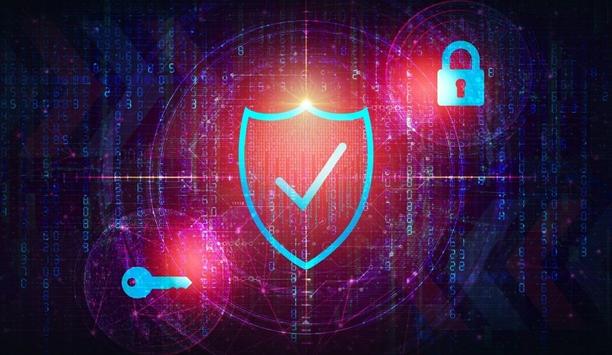
A modern guide to data loss prevention
Download
7 proven solutions for law enforcement key control and asset management
Download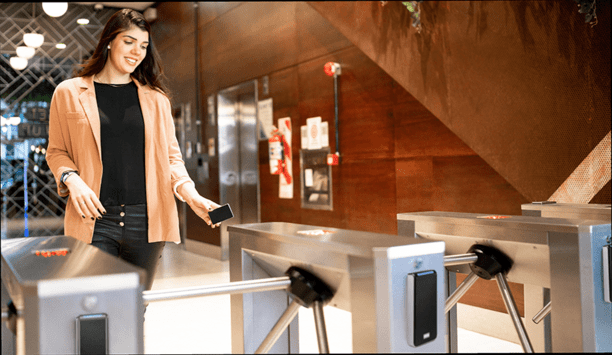
The truth behind 9 mobile access myths
Download
Access control system planning phase 2
Download










